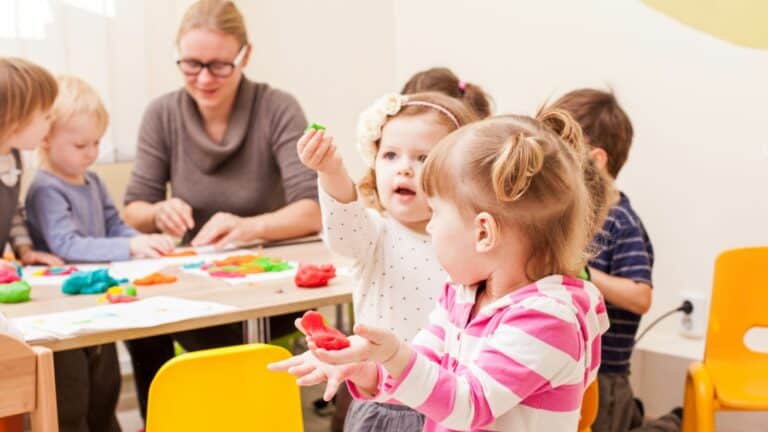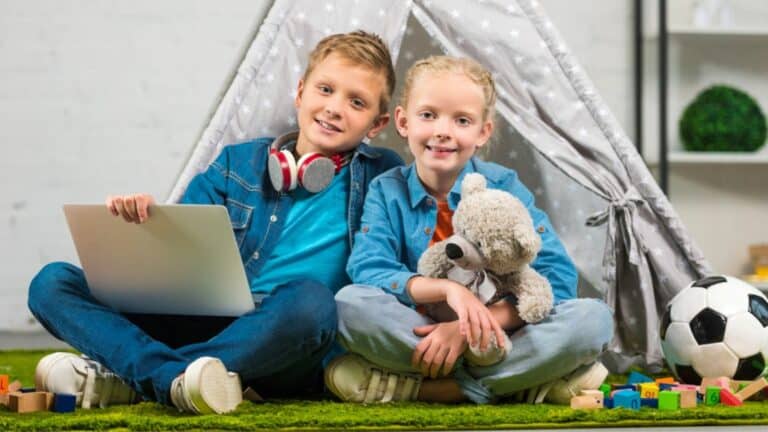The 6 Different Learning Styles for Kids: What Parents Need To Know

There are many different learning styles for kids to use in their everyday lives, whether homeschooling or attending a public or private school. Trying the various learning methods and identifying your child’s ideal technique will benefit their education and learning process considerably.
It’s essential to find opportunities for your child to participate in all different learning styles so they can identify which types resonate best and will benefit them the most. Every child will be different when finding what works for them.
Allowing your child to use the learning style that best suits them will result in them learning new information more efficiently while enjoying their education.
Why It’s Important To Identify Your Child’s Preferred Learning Style
1. It Will Help Them Build Confidence
Learning should be both challenging and enjoyable for children. Repeatedly forcing them to use a learning style that doesn’t work well with their brain will frustrate and disappoint them, which could ultimately cause a lack of self-confidence, as they feel like they aren’t smart or capable.
Once you’ve discovered which learning style works best for them, they are much more likely to enjoy learning and feel confident in their abilities to learn new things. This will help grow their confidence and encourage them to keep trying new things and take different educational approaches.
2. It Makes Learning More Enjoyable
It’s natural for kids to prefer an activity they enjoy over one they don’t. If you want your child to desire to learn new things, the best way to create that desire is by finding ways to make learning more enjoyable. Trying different learning activities for kids is a great way to find ideas for various types of learners to absorb new information.
3. It Can Help You Discover New Ways of Helping Them Learn
Once you’ve identified which learning method your child enjoys most, you can start brainstorming ways to help them utilize it in their studies. For example, if you discover your child learns best with a hands-on learning style, you can find some games or crafts related to their study topic.
How To Identify Your Child’s Preferred Learning Style
1. Watch What They Do When They Aren’t Given Instruction
You can learn so much about your child just by watching them. While learning or exploring, they will naturally do what feels intuitive or easy for them.
Observing how they process information and what they do while figuring things out can tell you much about their learning style and personality types. Pay special attention to their problem-solving skills; it is a great time to see how your child reacts to challenges.
2. Give Them Opportunities To Use All Learning Styles
Giving your child ample opportunity to use every learning style will help determine which type works best for them. They need to realize there are many different ways of learning. Allowing them to use different learning styles might open their minds to a new technique they haven’t tried before, and they end up thriving.
3. Ask Them Which Way of Learning They Like Best
After your child has tried multiple different learning techniques, ask them about their experience. Talking about the different styles with you might help them process their thoughts a little better and help them understand which types they enjoyed and didn’t.
Try asking them these questions:
- Which learning style, activity, etc., did you enjoy the most?
- Which type did you enjoy the least?
- What was challenging about your learning experience today?
- What was easy?
- Which learning styles would you like to try again?
- What new things did you learn today?
Benefits of Using a Range of Different Learning Styles
Some children might identify with multiple learning techniques or a combination of all types. While it’s essential to allow your child to use the style they resonate the most with, it is still important to encourage them to try other techniques from time to time, as there will be times when they will have to use different ways to learn things.
Part of being a good parent includes helping your child to enjoy their learning experience, as well as pushing them outside of their comfort zone once in a while. After identifying your students’ learning styles, you can start helping them explore different approaches to learning new concepts. Once they’ve built confidence by finding their favorite learning method, they will be more comfortable trying other styles, especially with your encouragement.
What Are The 6 Different Learning Styles?
There is no denying different people prefer different styles of learning. What works for one person might not work for another. Some people identify with multiple types of learning, and others struggle to find one method they resonate with.
Every student learns differently. A child’s favored learning style has much to do with their personality type, environmental factors, available resources, etc.
There are numerous different learning styles, but most of them can be categorized into the following list of six types:
- Visual learning
- Auditory learning
- Logical learning
- Kinesthetic learning
- Social learning
- Intrapersonal learning
How To Identify a Visual Learner
Visual learners, sometimes called spatial learners, learn best by watching and seeing the information in front of them. A visual person often learns best by watching a demonstration first. A visual learner might enjoy art, videos, or books with pictures, graphs, or charts.
Study Tips for Visual Learners
- Use flashcards for memorization
- Find visual aids such as graphs, photos, charts, etc.
- Utilize colors, cards, diagrams, and more when studying
How To Identify an Auditory Learner
Auditory learners, sometimes referred to as aural learners, prefer verbal communication and instruction over written ones. They might excel at auditory subjects, such as music. They might ask clarifying questions or talk, hum, or sing to themselves.
Study Tips for Auditory Learners
- Offer them opportunities to ask questions verbally
- Ask them to repeat what you said so you can make sure they understood
- Provide a quiet, distraction-free environment for studying
How To Identify a Logical Learner
Logical learners, sometimes called mathematical learners, will understand concepts best when given a rational and analytic explanation. They use analytical skills to learn and execute new skills or new information. They can identify patterns, enjoy statistics, and are often good with numbers.
Study Tips for Logical Learners
- Encourage making lists, spreadsheets, etc.
- Provide easy-to-follow-steps and instructions
- Ask questions that require deep thought
How To Identify a Kinesthetic Learner
Kinesthetic learners, sometimes referred to as tactile or physical learners, prefer a hands-on approach to learning. They learn best as they go and do whatever they are trying to learn. They enjoy physical activities, games, and other active learning activities that allow them to move around. They might have trouble sitting still and would benefit from an active learning environment.
Study Tips for Kinesthetic Learners
- Provide physical activities related to a topic to help them learn it, such as games, crafts, etc.
- Allow time for them to do some trial and error
- For times they have to sit and listen while learning, provide a fidget toy, such as a stress ball, to squeeze while they listen
How To Identify a Social Learner
Social learners thrive in learning environments with other people. They are often very extroverted and love to be around others. They enjoy the collaboration of group projects, study groups, etc. They are often great communicators and enjoy incorporating many different learning methods and techniques in a group situation.
Study Tips for Social Learners
- Find a study group, group discussion, or another social aspect for them to attend
- Ensure they get enough socialization with others each day
- Offer lots of educational games or other group activities such as these would you rather games for kids
How To Identify an Intrapersonal Learner
Intrapersonal learners, sometimes referred to as solitary learners, are the exact opposite of social learners. They are typically more introverted and prefer to learn and study independently. Social situations might make them anxious or overwhelmed. The additional stress of excessive socialization might cause difficulty in understanding the material.
Study Tips for Intrapersonal Learners
- Provide different ways of studying that don’t require another person, such as flashcards, art projects, online games for kids, etc.
- Ensure a calm learning environment
- Limit group projects and a large number of people and focus on individual work
Beyond The Classroom for Learning Styles for Kids
Understand children learn in different ways, and every child can benefit from identifying their preferred learning style. Some children will likely identify with multiple learning styles. Their preferred learning method may change over time.
Be sure to broaden your teaching styles and strategies, try many different teaching methods, and encourage your child to try all different learning styles. Whether they are working on assignments for academics, sports, arts, music, or any other study area, trying different learning styles can benefit their educational experience immensely!
This article originally appeared on Wealth of Geeks.






